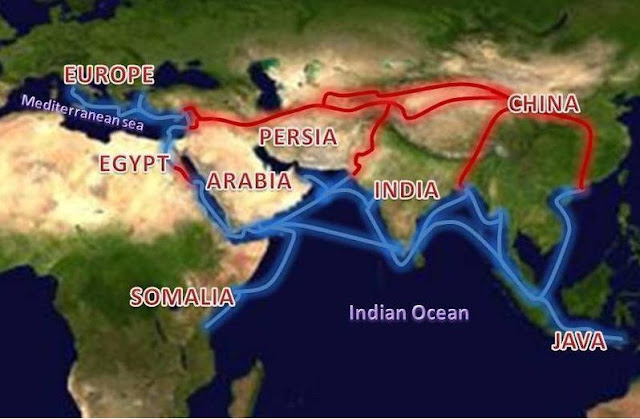The following map shows the ancient Silk Roads, which were trade routes that connected East Asia to Europe . With blue you can see the sea routes and with red the land routes.
Map 1 : The Silk Roads
A large part of the wars in history were due to the effort of controlling the Silk Roads, in order to secure the trade routes, to cut out parties that were charging commissions and taxes, and to block competing trading routes. The Greek King Alexander the Great conquered Persia (Iran ) and Egypt
Map 2 Empire of Alexander the Great 323 B.C.
I must say that the Silk Roads did not include any 100% sea route until the Suez Canal was opened by the British in 1869, and the Red Sea was finally connected to the Mediterranean Sea . Until then the sea routes of the Silk Roads would reach Egypt through the Red Sea, then they would become land routes, and in the Mediterranean Sea they would become sea routes again.
There was of course Vasco Da Gama and the Portuguese, who discovered the sea route around Africa in 1497-1499. The Portuguese wanted to avoid the Mediterranean Sea and the taxes charged by the Ottomans, and when they beat the Ottomans at the sea fight of Diu (India ) in 1509, they managed to keep a small portion of the trade around Africa . But Da Gama’s new trade route was not a replacement for the traditional Silk Roads, which are the most efficient connection between Europe and Asia . Inhospitable and costlier Siberia could not be a substitute for the Silk Roads either.
Map 3 The New Trade Route Opened by Vasco Da Gama in 1499
See also Vasco Da Gama and the Silk Roads
You can see on the map how important Egypt , Turkey and East Mediterranean Sea (Israel +Lebanon +Syria
Map 4 Roman Empire 117 A.D.
Map 5 Byzantine Empire 555 A.D.
Map 6 Ottoman Empire 1683A.D. – 1699A.D.
What is very important that is that things are still the same, with the main trading products being oil and natural gas, instead of silk and spice. There is still a war for the Silk Roads, with the Persians (Iranians) trying to reach the Mediterranean Sea (Iran-Syria pipeline), and the Turks and the Arabs trying to stop them (Qatar-Turkey pipeline). In the meantime the Turks and the Arabs are fighting each other for influence too. Actually there are Arabs that are today supporting the Persians i.e. the Alawites of Syira and the Shiites of Iraq.
Map 7 The War for the New Silk Roads in Syria and Iraq
Map 8 The Sunni VS the Shiite Pipelines
Moreover China China China has worked things out with Iran , Pakistan , Kazakhstan , Turkmenistan , who are very happy to be part of the New Silk Roads promoted by China Turkey , Russia and China in Central Asia ”.
and “The War for the Railways and the Motorways of the New Silk Roads”.
and
“China ’s Silk Road project gets port in Turkey
“China
There is also India , which is China
You can see that it is geography and not history repeating itself. History is limited by geography and therefore history always follows geography. The phrase “history is repeating itself” is not accurate. By saying “geography is repeating itself”, “geography does not change”, “the revenge of geography”, or something like that, one can be a great deal more accurate. Things are a lot more simple when the focus is put on geography. When the emphasis is on geography one simply needs to find which were the main powers of the time, what they were trading, and through which routes they were trading it.
I must also say that the Turkey ISIS gave to the media puts the the New Silk Roads under Turkish control. By doing so, ISIS will also operate as a cartel of oil and natural gas. See “ISIS : The Oil and Natural Gas Cartel”.
Map 8 : ISIS Map









Δεν υπάρχουν σχόλια:
Δημοσίευση σχολίου